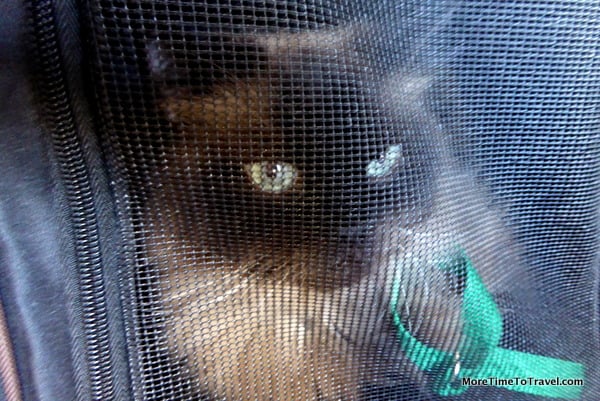Going Coastal: Taking A Cat On A Plane

We had to jump through hoops to travel with a cat on a plane.
When our adult son moved to California with more baggage than even a strapping young man could manage, we volunteered to bring his 10-year-old Himalayan cat, Java, a month later.
Turns out we needed much of that month to plan traveling with a cat on a plane. Here’s what we learned from our research and experience:
Tips for taking a cat on a plane
- Visit the vet within 30 days of departure to ensure your pet is healthy enough for travel and obtain documented proof of required vaccinations (which may be asked for at check-in).
- Most vets don’t advise the use of animal tranquilizers.
- For obvious reasons, don’t feed your pet or offer water during the hour before travel.
- Cats (or small dogs) can fly with a ticketed passenger either as checked cargo in the belly of the plane or as carry-on. However, certain breeds (that are brachycephalic or snub-nosed) cannot be checked. Most animal lovers prefer to travel with their “best friends” in the cabin (because it is safer) but must determine if the pet qualifies based on age, breed and size. Generally, the total weight of a carry-on animal cannot exceed 20 pounds with the carrier (case).
- Pets must remain in hard-sided kennels or soft-sided carriers that are ventilated and leak-proof, which will need to be stowed under the seat in front of the passenger at all times. The cramped space under seats make a strong case for purchasing a flexible, soft-sided carrier with mesh sides. Rules vary widely across airlines in terms of the permitted size dimensions of the carrier.
- It is wise to acclimate your pet to the carrier before you leave home.

- Travelers with pets cannot occupy bulkhead or emergency rows. Window seats generally offer more under-seat space than middle or aisle (some airlines require travelers with pets to reserve a window seat). The pet and carrier count against your carry-on allowance.
- Before you book, ask the airline whether you can take your pet on a particular flight. If you compare airlines, you’ll find that the rules for traveling with pets vary based on the configuration of the plane, class of service and destination. Book early because the number of pets allowed per flight is limited.
- To assure that both you and your pet get ticketed, you may have to call the airline (rather than purchase a ticket online) to simultaneously make arrangements and pay a non-refundable reservation fee for the pet (generally between $100-$125) and to secure a reservation and suitable seat for yourself. (You may incur an additional fee for booking by phone)
- For TSA screening, you will be required to remove your pet from its carrier; you can request that TSA screen your pet in a private area. Make sure your pet has an identification tag and leash (in case the animal gets frightened and bolts). After passing through security, pets must remain in carriers and aren’t permitted in airline clubs or lounges.
Traveling internationally is even more complex with different policies, additional paperwork, additional fees and greater risks.
Most important: Because pet policies differ for every airline and are subject to change, check specific websites in advance of your trip.
The table below provides some general guidance on flying with a cat:

In case you’re curious, Java handled the stress of air travel without a whimper and we didn’t need to purchase too many cocktails onboard for ourselves.

Links to pet policies for some major airline carriers
- Jet Blue
- United Airlines
- American Airlines
- Delta Air Lines
- Virgin America: Pet service currently unavailable
And if you can’t take the cat with you, read these helpful tips on how to care for your cat on vacation.
Save to Pinterest!!

[A version of this article by Irene S. Levine appeared in the Sunday travel section of the Chicago Tribune, the Hartford Courant and Aviation Pros.]





That is a lot of effort, though I am sure worth it. Did you know that if the animal is an Emotional Support Animal then you don’t have to worry about so much. Just a letter from a doctor or therapist …apparently. I do hear however, that there have been cases of people having a chook as their emotional support animal and it sits on a seat next to another passenger.
Yikes! I had to look up “chook” but when I did…
Me too!
Great article, Irene and so informative. I can’t wait until it hits the hard copy! Java’s a star…like his mom. 🙂
Actually, I’m the grandmother:-)
As far as I’m aware, we can’t have our pets with us in the cabin in Australia. You are so lucky to have been able to take Java with you. I’ve seen quite a few dogs on flights in Europe and instantly think of our poor old dog at home who would have loved a trip or two…Maybe I can claim her as an emotional support animal!
I came across a website that lists the different airline policies: See the maphappy.org link above.
According to the chart, Quantas doesn’t allow pets in the cabin.
I wouldn’t recommend flying with pets unless it is a necessity. It’s costly and creates “wear and tear” on the pet and the owner. I couldn’t wait for our flight to end because I was so nervous about Java.
Your article was great. I have been debating for a long time whether I should take my Burmese cat to France. Your information provided more information for me to consider. One thing I was disappointed with was: you can’t take a pet if you are in business class (at least for the flights I was looking to take from Toronto to Paris).
I think it’s because there is no room under the seats.
I flew with my beloved and recently departed ancient kitty a couple times. It was within the U.S. so I just bought her her “kitty ticket” and put her in her carry-on and took her. Luckily she was amazingly well behaved (probably better than I was). I did learn though that booking ahead of time is very important. There’s a max (can’t remember if it’s 3 or 4) pets per flight and legitimate service animals (not “emotional support animals”) always get priority. So the airlines reserve one of the “pet spaces” in case a blind person or someone else with a service animal shows up. Makes sense and means don’t wait until the last minute or you might have to pick another flight (says the voice of experience).
Yes! You definitely have to plan ahead!
I love the line “in case the animal gets frightened and bolts” ..that would have been our cat, Viva. Not only was she incredibly noisy but she was a slasher. If she escaped you would need someone in a flak jacket to try to capture her. We used to have to use oven mitts when trying to get her into the carrier. Java looks much more elegant and better behaved. Great info for cat owners and cat lovers, Irene!
It would be easy for any pet to get startled going through TSA — especially if they’ve never gone out of the house.:-)
Pete went through this process several years ago bringing his deceased sister’s cat from California to Minnesota, and we were amazed at all the hoops to jump! He was bringing her cremated remains, too, and between the two types of special circumstances, let’s just say the trip was complicated. Taking a cat on a plane is not for the faint-hearted.
Yes, I totally agree that it is nothing to be done on a whim. Java was making a permanent move.
What a helpful post! I have friends that flew their two cats coast to coast for a move, but I don’t think I’ll ever have to do that. Java is gorgeous. Perhaps you’d like to do another post on the topic of flying two infant twins, a 2-year-old, and a husband and wife coast to coast? My daughter is interested. 🙂
What a fortunate dilemma and how lucky you are!!!
I haven’t tackled traveling with twins (or even caring for them at home) but I did write an article for the Chicago Tribune about a year ago about traveling with babies.
Perhaps, it will have some useful tidbit for your daughter: https://www.moretimetotravel.com/infants-planes-younger-baby-easier-tips/
Warm regards, Irene
Loved this Irene. During our first foreign fling of home ownership in Mexico, just outside Puerto Vallarta, we drove there from Seattle and back with our two cats in August! That was nearly 18 years ago now and we can finally laugh about the experience!
That must have been some long drive, with or without two cats:-)
Hi! I was thinking about bringing my cat to Europe (from NYC), may be moving there for a year. My cat is a Himalayan like yours (i think?) and was wondering what airline you used, and whether Java had any breathing problems during the flight. Thank you!
They say that breathing problems are a risk with Himalayans but Java didn’t experience them at all. Our flight was several years ago. You should check the current pet policies of the few airlines that might fly to your destination because they change. Also, the rules may be different internationally. Good luck!